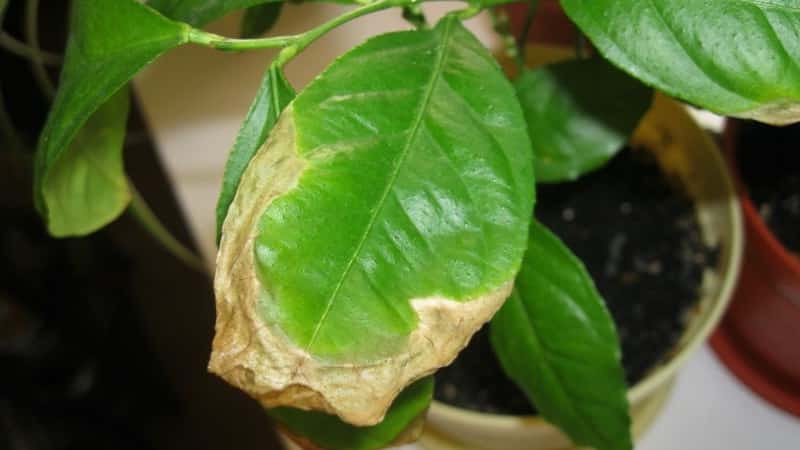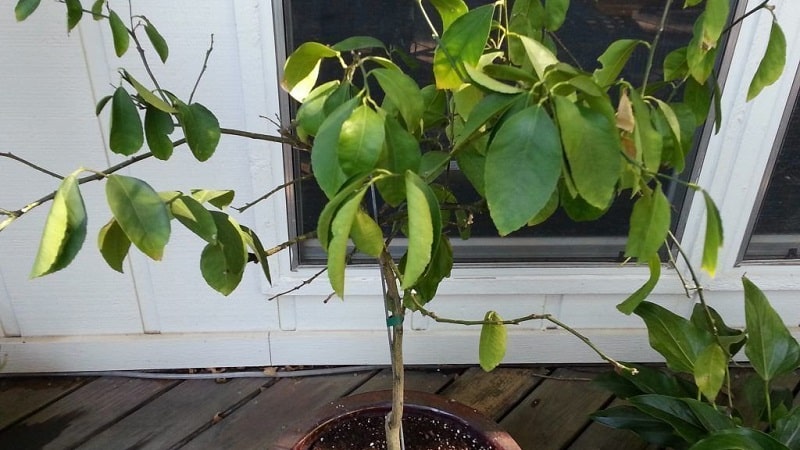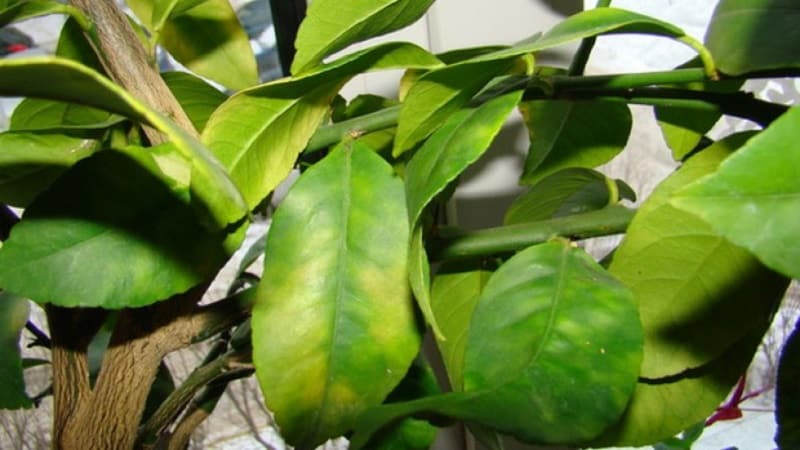Why do lemon leaves dry around the edges and how to fix the problem?
Lemon is a subtropical resident that, when grown at home, needs to maintain a comfortable climate. The plant loves moisture, sun, warmth, and does not tolerate cold, drafts, or lack of nutrition and moisture. Dry leaves and branches, shedding foliage out of season indicate that the plant is under stress. In this article we will talk about growing lemons at home, caring for them, and what to do if the lemon tree has dried out.
Why do lemon leaves dry out around the edges?
Most problems when growing indoor lemons arise from improper care.. The plant needs regular but moderate watering, sunlight, feeding with organic matter and minerals, maintaining temperature and air humidity.
Mature trees shed old leaves once a season, which should not be alarming florist But when the lemon turns yellow and leaves curl, the trunk and branches dry out, it is important to identify the cause of such processes and direct efforts to resuscitate the plant.

Lack of lighting
The harmonious development of the lemon tree depends on the level of light in the house. A lack of sunlight has a detrimental effect on the plant and leads to dry tips and yellowing of the leaf blade.
The normal daylight hours for a lemon is 12 hours.. The tree is placed on or near the windowsill on the southwest or south side to provide comfortable conditions for growth and development.Otherwise, the lemon is illuminated with a phytolamp.
Excess sunlight often causes yellowing and dry leaves.. At the same time, the branches and trunk of the tree dry out. Direct sunlight penetrates the glass and causes burns on the delicate leaves, so gardeners do not advise placing lemon trees on sun-drenched window sills.
It is better to place the pot on a cabinet near the window or shade it with a chintz curtain.
Over or under watering
Lemon is a moisture-loving plant, so due to a lack of moisture, its leaves become dry and curled.. In summer it is watered every day; in dry weather the frequency of watering is doubled. Water is poured in small portions and the soil is constantly checked for moisture content. The finger is immersed 2-3 cm into the ground. If it’s dry, then it’s time to add a portion of water.
A dry trunk and branches also indicate excess moisture.. Excessive watering causes rotting of the root system and rapid death of the plant. In this case, it will no longer be possible to save it, but from the cut and rooted cuttings it will be possible to grow a new tree.
If there are no drain holes in the pot or are clogged, or drainage material that does not allow water to pass through was used during planting, the root system will begin to rot. Excessive humidity causes oxygen starvation of the plant, shedding and yellowing of foliage.
Water quality and temperature also affect the condition of the tree. For irrigation, use clean, settled, filtered or spring water at room temperature. The lemon trunk also dries out when watered with ice water, which causes shock to the root system.
Interesting things on the site:
Soil depletion
The growth and development of indoor lemon depends on the nutritional value of the soil.. For planting, use soil mixtures marked “For citrus plants.” After planting, the young plant is fed weekly with liquid fertilizers for lemon (Rocon, Bona Forte, “Fasco”, “Garden of Miracles Lemon”, “Zdraven”, “Organic Mix”). In conditions of deficiency of nutritional components, the lemon quickly sheds its leaves, and the trunk and branches begin to dry out.
In summer, the lemon grows and gains green mass. During this period it is recommended Apply fertilizer once a week. In winter, they switch to a gentle regime and feed the plant once every 2 weeks.
At home lemon is fertilized with improvised means:
- Nitrogen. Silt or crushed quinoa leaves are placed as a top layer of soil in a pot with a plant or watered with a 0.5% solution of nitrate.
- Phosphorus. 2 g of bone glue is mixed with 1 liter of water, boiled for half an hour, cooled and poured over the lemon. 50 g of superphosphate is added to the fermented slurry and the plant is fed.
- Calcium, phosphorus, potassium. These substances are found in wood ash. For 1 liter of water add 1 tbsp. l.
- Coffee grounds or tea leaves, which contain magnesium, potassium, calcium, phosphorus, manganese, copper, iron and are suitable as an auxiliary feeding.
- Dark solution of potassium permanganate. It nourishes the plant and disinfects the soil.
- Organic. Manure or bird droppings are diluted with water, fermented for 10 days, then diluted with water 1:15.

Dry indoor air
The heating season negatively affects indoor air quality; it becomes drier.
Lemon reacts to changes in microclimate with dry and curled leaves.. The situation will be corrected by spraying the tree 3 times a day, installing an air humidifier or a container of water next to the pot.For spraying use clean, filtered water. It won't work from the tap because it leaves a white residue on the foliage.
Sphagnum moss or damp cotton cloth will help retain moisture in the soil and prevent drying out of the root system.
Reference. The air humidity in the room for growing lemon is 60%.
Temperature violation
Sudden changes in indoor air temperature cause dry leaves. Citrus fruits love warmth and are afraid of cold and drafts. The tree pot is placed away from windows and doors.
In winter, lemons are removed away from radiators, since overheating of the earthen clod and the plant itself leads to dropping leaves. The room is regularly ventilated, making sure that air flows do not hit the tree.
Most varieties can easily withstand a gradual decrease in temperature from +25 to +10°C. Comfortable indicators for citrus fruits are +20…+22°C.
The emergence of pests and diseases
Spider mites settle on lemon trees and cause dry leaves and branches. When attacked by scale insects, growths and dry areas appear on the leaves.
Methods for exterminating pests:
- Pour 100 g of onion peel into 200 ml of warm water, leave for 24 hours, then water the soil and spray the leaves;
- grind the head of garlic in a mortar, add 200 ml of warm water, leave for 5 days in the dark, strain and spray on the leaves;
- Pour 100 g of dry yarrow herb into 1 liter of boiling water, put on low heat for half an hour, strain, cool and spray on the leaves;
- Pour 100 g of dry Datura into 1 liter of warm water, leave for 24 hours, strain, mix in 5 g of laundry soap shavings, then treat the plant;
- 100 g of dried henbane pour 1 liter of boiling water, leave for 24 hours, strain and process the lemon;
- A solution of colloidal sulfur is used in this way - spray the lemon leaves with water mist and blow the powder off the paper onto them;
- “BI-58” (10 drops per 200 ml of water) - treat in the evening, after 2 days wash the foliage with running water;
- "Karbofos" - process according to instructions, the product destroys aphids and spider mites;
- INSEKT SPRAY - aerosol for home use;
- Plint Pin arrows against spider mites are stuck into the ground, 3-4 pcs. on the potty;
- "Aktara" against scale insects, thrips, aphids - 0.4-0.8 g per 1 liter for treating lemons;
- "Tiofos" against scale insects - 3-5 treatments with an interval of 10-20 days.

All the leaves of the lemon have fallen off and the branches are drying up - what to do?
Success of resuscitation and lemon tree treatment depends on the speed of identifying the cause of dry leaves and branches. At the initial stage, the problem can be solved quickly, but delay threatens the loss of the tree.
If, due to excessive watering, the roots begin to rot, the lemon is transplanted into a new pot with a complete replacement of the soil. Damaged roots are cut off, the remaining ones are washed in a solution of potassium permanganate.
If sunburn appears on the leaves, the plant is transferred to partial shade or covered from scorching rays with curtains.
Damaged and dry leaves are removed, young green leaves appear instead.
The room maintains a comfortable air temperature and humidity level. The tree is placed under a shower every six months to wash away dust and spider mites from the foliage, but after that it is watered when the soil has dried 4-5 cm.
How to revive a dried indoor lemon
Even with proper care, indoor lemons dry out and lose their leaves. When a tree is monitored, it is much easier to maintain its health.However, citrus growers often give up when they see a plant in poor condition.
Our tips will help you understand how to revive Pavlova lemon and give it a second life:
- Place the pot on the balcony in a bright place.
- Remove the lemon from the pot to inspect the roots, remove any dead ones and leave at least 80% of the total mass.
- Cut off the dry branches along with the foliage; they cannot be saved.
- Place the plant in a sterile substrate and under a bag for 30 days.
- Stop feeding the plant until the cause of the dryness is determined.
- Plant the lemon in loose, light, breathable soil.
- Before planting, add coconut, peat, perlite and 20 g of superphosphate to the new substrate.
- Water after the top layer of soil dries out.
- Plant grass or spread moss to prevent soil acidification.
- Water the plant with Radifarm, Energen Aqua, and spray with a solution of Zircon and Ecogel once a week.
Conclusion
Experienced citrus growers know what to do if the lemon has dried out. They recommend maintaining the indoor air temperature in the range of +20...+22°C, humidity at 60%, watering the plant only after the top layer of soil has dried, and monitoring the condition of the root system.
For lemon, overwatering is worse than moisture deficiency. In such cases, the roots begin to rot, which leads to the death of the tree. Lemon leaves dry out when infected with spider mites and scale insects. Folk remedies and insecticides are used for destruction.
Thank you very much for your course on citrus agricultural technology!
I would like to inform you that in Russia there is an ancient good custom of planting/replanting shrubs/trees: it is necessary that a man and a woman be involved, that is, TWO OF THEM!
It is believed that this is for the health and fertility of the plant.